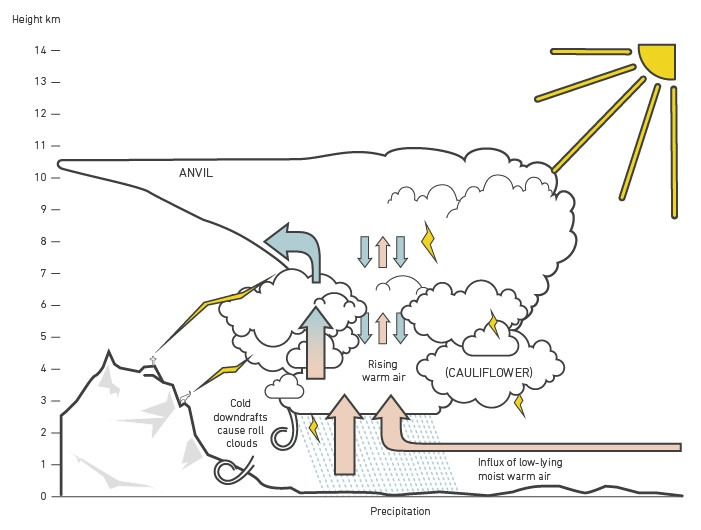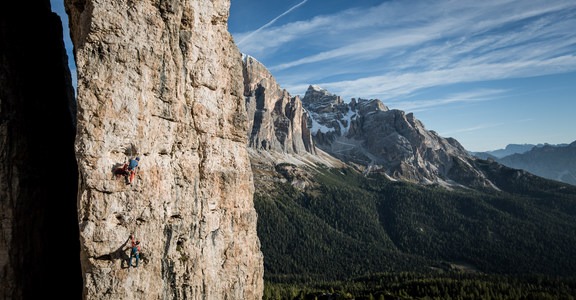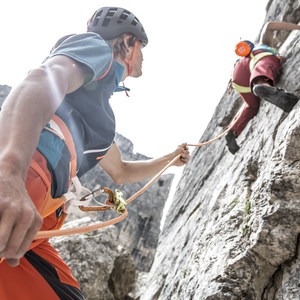The weather as a critical factor in alpine climbing
The weather is an extremely important factor on every mountain and climbing tour, especially when it comes to safety. This is why the weather forecast plays a key role, even as early as the planning stage. But your own weather observations are also crucial in detecting thunderstorms in good time and in making appropriate decisions at an early stage. There are essentially two types of thunderstorm: heat thunderstorms and frontal thunderstorms.
- Heat thunderstorms are local thunderstorms with heavy rain and lightning which occur in the summer months due to temperature rise. The air near the ground is rapidly warmed by intense sunlight and, once it reaches a certain temperature, it rises as humid hot air, because it is warmer and thus lighter than its surrounding air. The rising air then cools down and condenses in the higher, colder atmosphere, leading to thermal thunderstorms. Heat thunderstorms can be identified by a swelling cloud formation resembling an anvil (cumulonimbus). Alarm signals for heat storms:
- Little to no morning dew
- Muggy air and very little wind
- Sharp cloud edges and strong swelling (Castellanus) in the morning
- Observe the course of the cloud formation that can lead to a thunderstorm: from cumulus clouds (isolated, dense and sharply marked out cloud) to castellanus clouds (partial swelling and crenellated appearance) to cumulonimbus clouds (storm clouds, mostly in the shape of an anvil)
- Heat thunderstorms can also occur in stable high pressure conditions

- Frontal thunderstorms are year-round storms that are accompanied by continuous rainfall, a drop in temperature or strong winds. They occur when two opposing weather fronts meet, pushing the air masses under each other. These air mass shifts are particularly prevalent along cold fronts (see graphic): Cold, dense air masses push themselves under the warmer layers of air closer to the ground. These layers are then forced to rise and produce strong winds. Upon reaching a certain height, the air condenses, forming cumulus clouds, which may then develop into storm clouds under certain conditions. Frontal thunderstorms extend over larger areas than heat thunderstorms would. Alarm signals for frontal thunderstorms:
- Gathering of a dark cloud wall from the weather direction
- Longer-lasting weather deterioration
- Is usually associated with a drop in temperature (icing, snowfall at higher altitudes)

NOTE: The weather forecast plays a key role, even as early as the planning stage. Alpine climbs should only be planned and climbing on the rock face only commenced under stable conditions. Frontal thunderstorms are forecast in good local weather reports. As is a likelihood of heat storms! If a storm occurs in spite of good planning, ensure you do the following:
- Seek out a sheltered place, such as a cave, recess or overhang away from conductive materials.
- In steep terrain, ensure you are protected from falling.
- Sit in a crouched position on your backpack or rope under a bivi bag and wait until the storm is over.
- Only descend once the storm is over.
- Attention: There is also a danger of falling rocks or hypothermia.
Avoid at all costs:
- Never stay on the summit during a storm. Descend in good time.
- Do not act rashly.
- Do not move across unprotected steep terrain.
- Do not separate from your climbing partner/group.
Check out the full series of Safety Academy Lab Rock videos below:
- Alpine basics
- Basic equipment for every climber
- Basic equipment for groups
- Additional equipment for groups
- Storms in the mountains
- Types of rock in the Alps
- Tour planning for alpine climbing
- Packing a backpack correctly
- Rope team procedures
- Knot techniques
- Belay using bolts
- Belay methods
- Anchors
- Coiling a climbing rope
- Rappelling
- What to do in an alpine emergency
- First aid on the mountain
- Rescue techniques while alpine climbing
- Bivouacking in an emergency situation
Visit ORTOVOX’s Safety Academy Lab Rock to view the climbing tutorials in their totality and test your knowledge with their fun and interactive quizzes.
Since the company was founded in 1980 in the south of Munich, ORTOVOX has stood for the highest possible protection during alpine activities. As pioneers in the avalanche safety field, we have played a key role in the development of emergency equipment for the mountains. Innovations such as the double-frequency avalanche transceiver and Smart Antenna Technology, and also targeted training measures, continue to be valuable contributions to making mountain sports a little bit safer and to saving lives.






Comments
Sign In and share them.